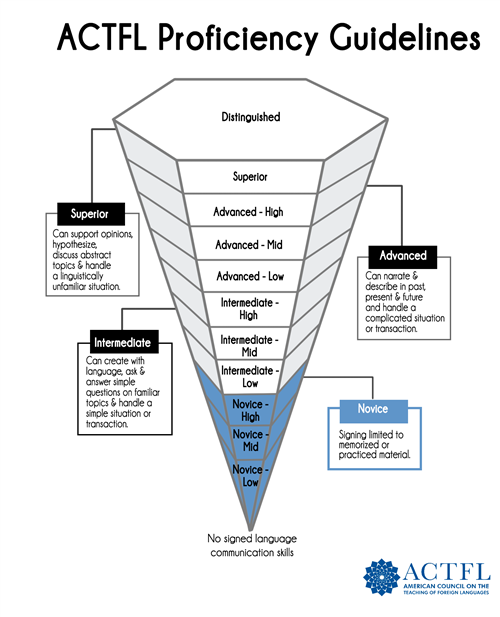World Language
Page Navigation
-
What will I be able to do in ASL 1
 ?
?
According to the Texas Essential Knowledge and Skills for language other than English or TEKS, students in ASL Level I proficiency levels, as defined by ACTFL and ASLTA, are as follows:
- interpersonal receptive: novice mid
- interpersonal expressive: novice mid
- interpretive receptive: novice high
- presentational expressive: novice high
-
Students in ASL Level I develop the ability to perform the tasks of the novice language learner.
The novice language learner, when dealing with familiar topics, should understand ASL phrases receptively and respond expressively with learned material; sign learned words, concepts, phrases, and sentences; recognize the importance of communication and how it applies to the American Deaf culture; and recognize the importance of accuracy of expression by knowing the components of ASL. Students use expressive and receptive skills for comprehension.

 Interpretive Receptive:
Interpretive Receptive:At the Novice level, listeners can understand key words and formulaic expressions that are highly contextualized and highly predictable, such as those found in introductions and basic courtesies. Novice-level signers understand words and phrases from simple questions, statements, and high-frequency commands. They typically require repetition, rephrasing, and/or a slowed rate of signing for comprehension. They rely heavily on extralinguistic support to derive meaning such as body language and facial expressions.
Novice-level signers are able to get a limited amount of information from highly predictable scenarios in which the topic or context is very familiar, such as a hotel bill, a credit card receipt, or a weather map. Signers at the Novice level may rely heavily on their own background knowledge and extralinguistic support (such as the imagery on the weather map or the format of a credit card bill) to derive meaning. .

 Presentational Expressive / Receptive & Expressive:
Presentational Expressive / Receptive & Expressive:Novice-level signers can communicate short messages on highly predictable, everyday topics that affect them directly. They do so primarily through the use of isolated signs and phrases that have been encountered, memorized, and recalled. Novice-level speakers may be difficult to understand even by the most sympathetic interlocutors accustomed to non-native speech.
Writers at the Novice level are characterized by the ability to produce lists and notes, primarily by writing words and phrases. They can provide limited formulaic information on simple forms and documents. These writers can reproduce practiced material to convey the most simple messages. In addition, they can transcribe familiar words or phrases, copy letters of the alphabet or syllables of a syllabary, or reproduce basic characters with some accuracy.
-
The FBISD ASL 1 Curriculum is comprised of five units of up
to three concepts each:
SEMESTER 1:
Unit 1 – Getting to Know You
- Concept #1: Greetings
- Concept #2: Basic Expressions
- Concept #3: Hearing Loss
Unit 2 – Relationships
- Concept #1: Families
- Concept #2: Sharing the Culture
SEMESTER 2:
Unit 3 – A Typical Teenage Life
- Concept #1: School Life
Unit 4 – Life Outside of School
- Concept #1: Activities
- Concept #2: Making Connections
- Concept #3: Socializing
Unit 5 – Reflections
- Concept #1: Storytelling
- Concept #2: Deaf History
 Follow us on Twitter: @RPHS_World | @RPHS_ASLClub
Follow us on Twitter: @RPHS_World | @RPHS_ASLClub
-
ASL 1 Teacher:
 J
J
-
MODES OF COMMUNICATION:
 Interpersonal: Learners interact and negotiate meaning in spoken, signed, or written conversations to share information, reactions, feelings, and opinions.
Interpersonal: Learners interact and negotiate meaning in spoken, signed, or written conversations to share information, reactions, feelings, and opinions. Presentational: Learners present information, concepts, and ideas to inform, explain, persuade, and narrate on a variety of topics using appropriate media and adapting to various audiences of listeners, readers, or viewers
Presentational: Learners present information, concepts, and ideas to inform, explain, persuade, and narrate on a variety of topics using appropriate media and adapting to various audiences of listeners, readers, or viewers Interpretive: Learners understand, interpret, and analyze what is heard, read, or viewed on a variety of topics.
Interpretive: Learners understand, interpret, and analyze what is heard, read, or viewed on a variety of topics.

